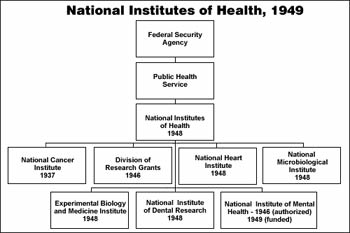|
|
 |
|
Accompanying growth in the grants program was the proliferation of new
categorical institutes. Between 1946 and 1949, voluntary health
organizations spurred Congress to create institutes for research on mental
health, dental diseases, and heart disease. In 1948, language in the
National Heart Act also made the name of the umbrella organization plural:
National Institutes of Health. The original divisions of the old National
Institute of Health were divided into two newly created institutes: the
National Microbiological Institute (NMI) and the Experimental Biology and
Medicine Institute (EMBI). The tradition of using such academic medical
names, however, was being transformed by the conviction that institutes
named after diseases stood a better chance for being funded by Congress.
In 1950, the EMBI was absorbed by the newly created National Institute of
Arthritis and Metabolic Diseases. In 1955 the NMI similarly became part of
the National Institute of Allergy and Infectious Diseases. By 1960 there
were ten components. This number increased by 1970 to 15, and by 1998 the
NIH had 27 institutes and centers.
In addition, specialized offices such as the Office of AIDS Research,
were created but subsumed administratively under existing components.

Back
To Top | Photography
Credits |
|
|
 |

